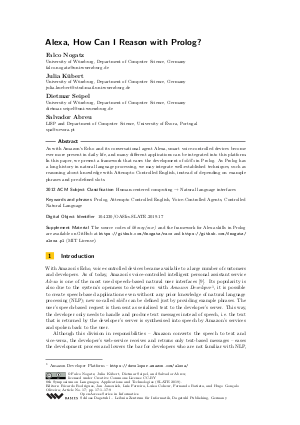Alexa, How Can I Reason with Prolog?
Authors Falco Nogatz, Julia Kübert, Dietmar Seipel, Salvador Abreu
-
Part of:
Volume:
8th Symposium on Languages, Applications and Technologies (SLATE 2019)
Part of: Series: Open Access Series in Informatics (OASIcs)
Part of: Conference: Symposium on Languages, Applications and Technologies (SLATE) - License:
 Creative Commons Attribution 3.0 Unported license
Creative Commons Attribution 3.0 Unported license
- Publication Date: 2019-07-24
File

PDF
OASIcs.SLATE.2019.17.pdf
- Filesize: 1.16 MB
- 9 pages
Document Identifiers
Subject Classification
ACM Subject Classification
- Human-centered computing → Natural language interfaces
Keywords
- Prolog
- Attempto Controlled English
- Voice-Controlled Agents
- Controlled Natural Language
Metrics
- Access Statistics
-
Total Accesses (updated on a weekly basis)
0Document
0Metadata
Abstract
As with Amazon’s Echo and its conversational agent Alexa, smart voice-controlled devices become ever more present in daily life, and many different applications can be integrated into this platform. In this paper, we present a framework that eases the development of skills in Prolog. As Prolog has a long history in natural language processing, we may integrate well-established techniques, such as reasoning about knowledge with Attempto Controlled English, instead of depending on example phrases and pre-defined slots.
Cite As Get BibTex
Falco Nogatz, Julia Kübert, Dietmar Seipel, and Salvador Abreu. Alexa, How Can I Reason with Prolog?. In 8th Symposium on Languages, Applications and Technologies (SLATE 2019). Open Access Series in Informatics (OASIcs), Volume 74, pp. 17:1-17:9, Schloss Dagstuhl – Leibniz-Zentrum für Informatik (2019)
https://doi.org/10.4230/OASIcs.SLATE.2019.17
BibTex
@InProceedings{nogatz_et_al:OASIcs.SLATE.2019.17,
author = {Nogatz, Falco and K\"{u}bert, Julia and Seipel, Dietmar and Abreu, Salvador},
title = {{Alexa, How Can I Reason with Prolog?}},
booktitle = {8th Symposium on Languages, Applications and Technologies (SLATE 2019)},
pages = {17:1--17:9},
series = {Open Access Series in Informatics (OASIcs)},
ISBN = {978-3-95977-114-6},
ISSN = {2190-6807},
year = {2019},
volume = {74},
editor = {Rodrigues, Ricardo and Janou\v{s}ek, Jan and Ferreira, Lu{\'\i}s and Coheur, Lu{\'\i}sa and Batista, Fernando and Gon\c{c}alo Oliveira, Hugo},
publisher = {Schloss Dagstuhl -- Leibniz-Zentrum f{\"u}r Informatik},
address = {Dagstuhl, Germany},
URL = {https://drops.dagstuhl.de/entities/document/10.4230/OASIcs.SLATE.2019.17},
URN = {urn:nbn:de:0030-drops-108841},
doi = {10.4230/OASIcs.SLATE.2019.17},
annote = {Keywords: Prolog, Attempto Controlled English, Voice-Controlled Agents, Controlled Natural Language}
}
Author Details
Supplementary Materials
- The source codes of library(race) and the framework for Alexa skills in Prolog are available on GitHub at https://github.com/fnogatz/race and https://github.com/fnogatz/alexa.pl (MIT License).
References
-
Norbert E. Fuchs. First-Order Reasoning for Attempto Controlled English. In International Workshop on Controlled Natural Language, pages 73-94. Springer, 2010.

-
Norbert E. Fuchs, Kaarel Kaljurand, and Tobias Kuhn. Attempto Controlled English for Knowledge Representation. In Reasoning Web, pages 104-124. Springer, 2008.

-
Norbert E. Fuchs, Kaarel Kaljurand, and Gerold Schneider. Attempto Controlled English Meets the Challenges of Knowledge Representation, Reasoning, Interoperability and User Interfaces. In FLAIRS Conference, volume 12, pages 664-669, 2006.

- Norbert E. Fuchs, Uta Schwertel, and Rolf Schwitter. Attempto Controlled English (ACE) Language Manual Version 3.0. http://attempto.ifi.uzh.ch/site/pubs/papers/ace3manual.pdf, 1999.
-
W. Wayt Gibbs. Build your own Amazon Echo - Turn a PI into a voice controlled gadget. IEEE Spectrum, 54(5):20-21, 2017.

-
Stefan Hoefler. The syntax of Attempto Controlled English: An abstract grammar for ACE 4.0. Technical Report ifi-2004.03, Department of Informatics, University of Zurich, 2004.

-
Hans Kamp and Uwe Reyle. From discourse to logic: Introduction to modeltheoretic semantics of natural language, formal logic and discourse representation theory, volume 42. Springer, 2013.

-
Irene Lopatovska, Katrina Rink, Ian Knight, Kieran Raines, Kevin Cosenza, Harriet Williams, Perachya Sorsche, David Hirsch, Qi Li, and Adrianna Martinez. Talk to me: Exploring user interactions with the Amazon Alexa. Journal of Librarianship and Information Science, page 0961000618759414, 2018.

-
Gustavo López, Luis Quesada, and Luis A Guerrero. Alexa vs. Siri vs. Cortana vs. Google Assistant: a comparison of speech-based natural user interfaces. In International Conference on Applied Human Factors and Ergonomics, pages 241-250. Springer, 2017.

-
Jan Wielemaker. SWI-Prolog version 7 extensions. In Workshop on Implementation of Constraint and Logic Programming Systems and Logic-based Methods in Programming Environments, pages 109-123, 2014.

